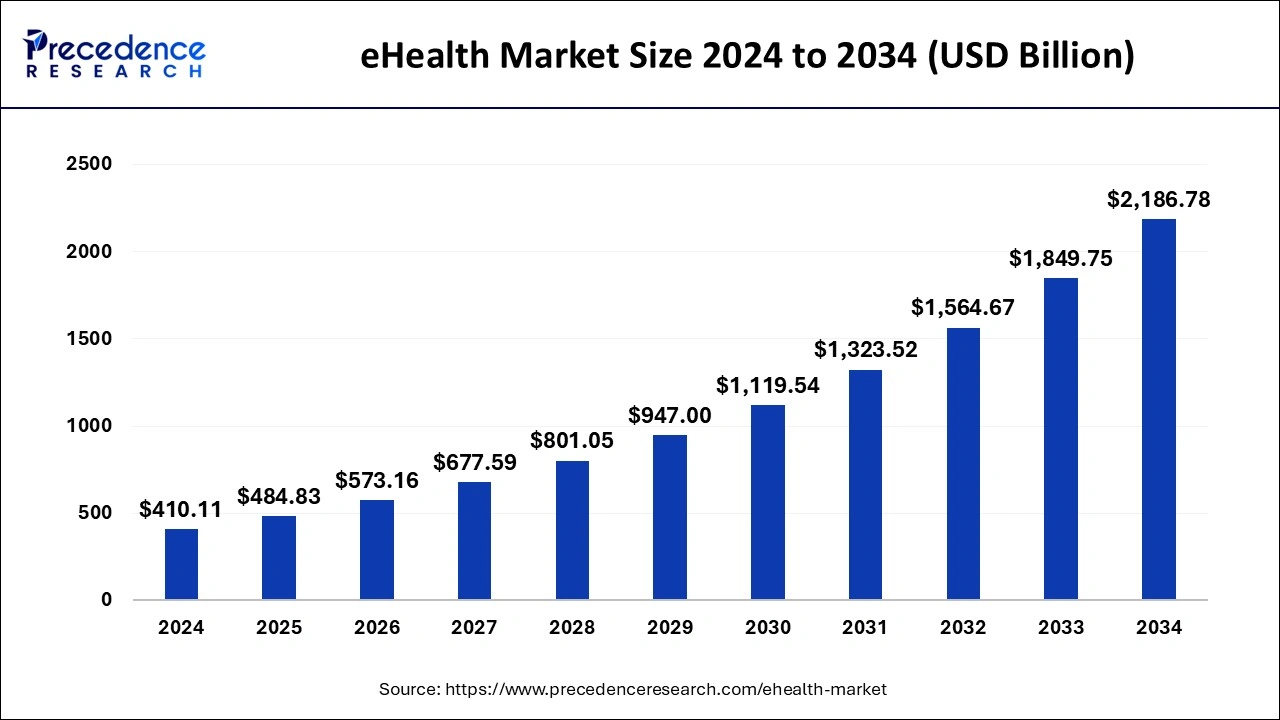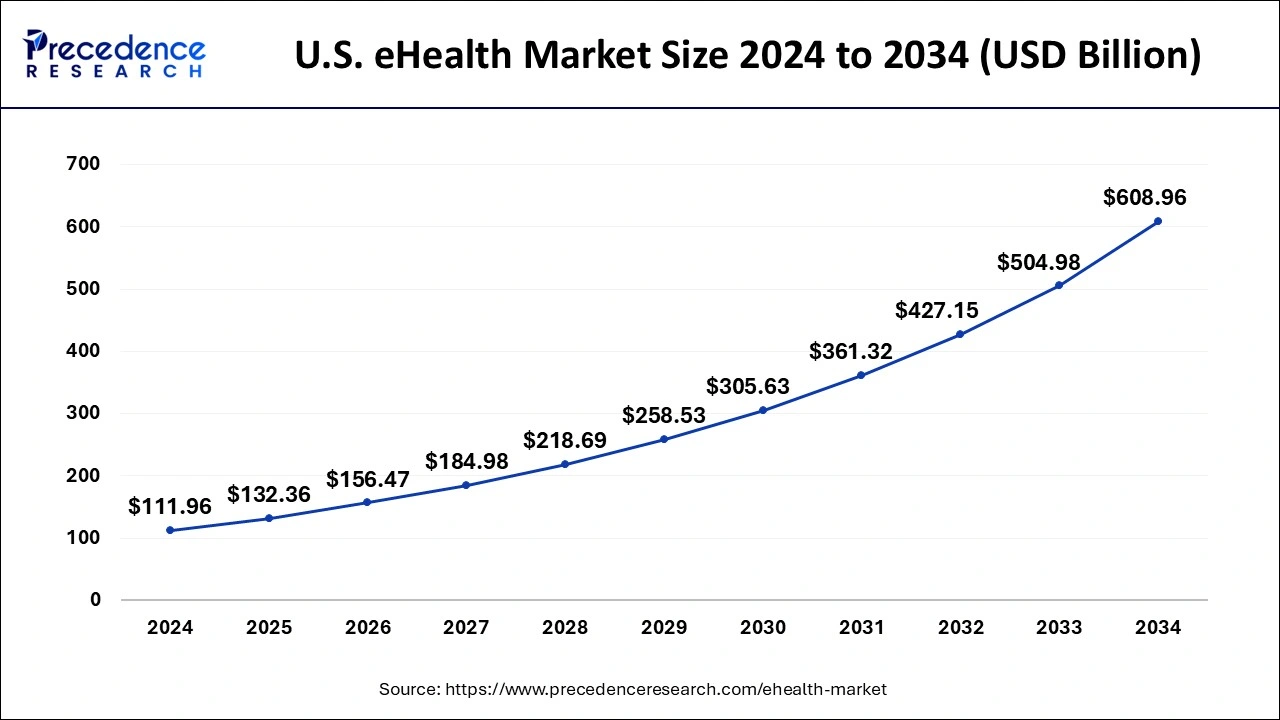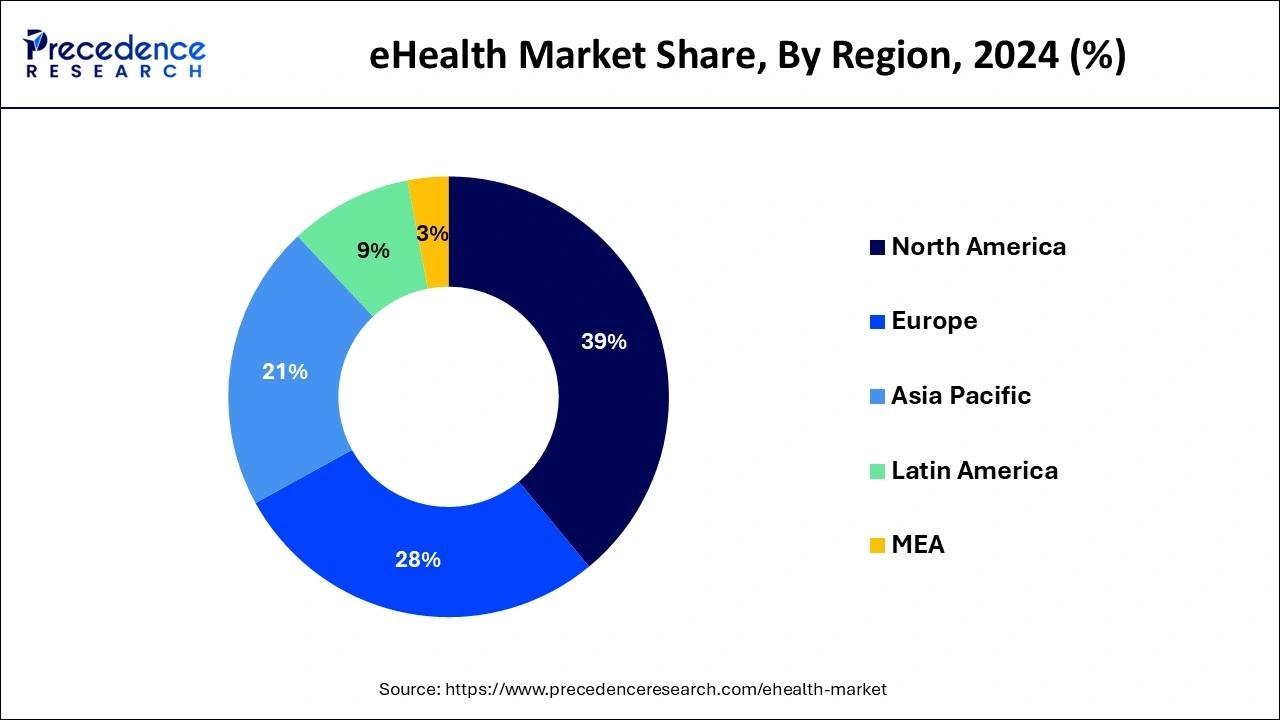The global eHealth market size is accounted at USD 484.83 billion in 2025 and is forecasted to hit around USD 2,186.78 billion by 2034, representing a CAGR of 18.22% from 2025 to 2034. The North America market size was estimated at USD 159.94 billion in 2024 and is expanding at a CAGR of 18.37% during the forecast period. The market sizing and forecasts are revenue-based (USD Million/Billion), with 2024 as the base year.
The global eHealth market size was calculated at USD 410.11 billion in 2024 and is predicted to reach around USD 2,186.78 billion by 2034, expanding at a CAGR of 18.22% from 2025 to 2034. Global digitalization and digitization along with significant investment by federal governments in healthcare infrastructure is driving demand in the eHealth market.

AI has an important role in the evolution of the eHealth market by introducing advanced technologies which can improve patient care, and personalized medication, and enhance operational efficacy, treatment plans, and diagnostics. The growing trend for virtual assistance, decision support methods, and artificial intelligence-powered chatbots can provide enhanced support for medical advice. It can track the real-time condition of the patient and help medical professionals to share reports with patients. The implementation of artificial intelligence and rapid advances in natural language processing are providing diagnostic support and assisting pre-checkup information gathering from patients.
The U.S. eHealth market size was exhibited at USD 111.96 billion in 2024 and is projected to be worth around USD 608.96 billion by 2034, growing at a CAGR of 18.45% from 2025 to 2034.

North America dominated the global eHealth market in 2024, in terms of revenue and is expected to retain its dominance throughout the forecast period. The increased burden of various chronic diseases and the presence of huge geriatric population in US has significantly driven the market growth.

Moreover, the high disposable income, higher adoption of the digital technologies, and increased healthcare expenditure has supported the North America ehealth market. The presence of numerous number of platforms is positively contributing to the market growth. According to NCBI, over 40,000 health apps were available for download on Apple iTunes store in 2013 in US. Thus, rapid growth of the ehealth apps has exponentially driven the growth of the ehealth market.
Asia Pacific is expected to be the fastest-growing market during the forecast period. The rising government expenditure on the development of sophisticated and digital healthcare infrastructure is fueling the demand for the ehealth platforms. Furthermore, the surging prevalence of various diseases and the rapidly growing geriatric population is expected to drive the market growth in the region. According to the United Nations, about 80% of the global geriatric population will be living in the low and middle income countries by 2050. Furthermore, the rising technological advancements and surging penetration of the smartphones and internet is expected to positively impact the market growth in Asia Pacific.
| Report Coverage | Details |
| Market Size in 2025 | USD 484.23 Billion |
| Market Size by 2034 | USD 2,186.78 Billion |
| Growth Rate from 2025 to 2034 |
CAGR of 18.22% |
| Largest Market | North America |
| Fastest Growing Market | Asia Pacific |
| Base Year | 2024 |
| Forecast Period | 2025 to 2034 |
| Segments Covered | Product, Service, End User, Deployment, Geography |
The electronic health record (HER) segment dominated the global ehealth market, accounting for a market share of more than 25% in 2024. The surging need for the reduction of paperwork in the hospitals and maintaining an easily accessible and transferable health record of the patients has boosted the growth of the HER across the developed countries. Furthermore, the rising government initiatives to digitalize the operations in the hospitals and increase the operational efficiency has fostered the growth of the HER segment. For instance, My Health Record is a digital health record platform for the Australian citizens.
On the other hand, mhealth is expected to gain rapid traction during the forecast period. This is attributed to the rapidly growing mhealth startups in the various developed and developing countries and the rising adoption of the mhealth platforms among the consumers. The surging adoption of smartphones and improved access to the internet is expected to fuel the growth of the mhealth segment.
Based on the services, the monitoring segment accounted for a market share of more than 60% in 2024. The surging health awareness and growing adoption of self-monitoring devices has fueled the growth of this segment. The ehealth allows the patients to analyze health conditions and automatically transfer the vital health information to the database. Thus the surging adoption of the monitoring devices is driving the growth of this segment across the globe.
Based on the end use, the healthcare providers segment dominated the global ehealth market in 2024. This is attributed to the rapid surge of the ehealth and other digital technologies in the hospitals and clinics across the globe. The rising government initiatives to digitalize the healthcare sector to enhance the operational efficiency of the healthcare units have boosted the growth of the segment.
On the other hand, the insurer is estimated to be the most opportunistic segment during the forecast period. The rising adoption of the ehealth among the insurers to keep the track of the health conditions of their customers and preparing insurance policies is driving the growth of this segment.
By Product
By Service
By End Use
By Deployment
By Geography
For inquiries regarding discounts, bulk purchases, or customization requests, please contact us at sales@precedenceresearch.com
No cookie-cutter, only authentic analysis – take the 1st step to become a Precedence Research client